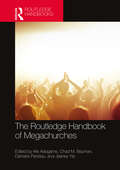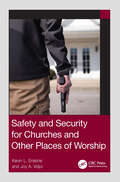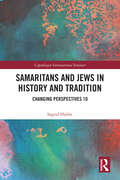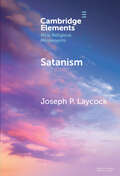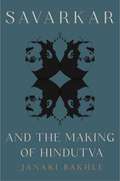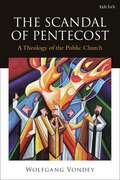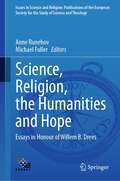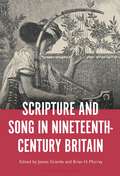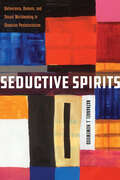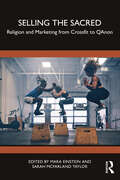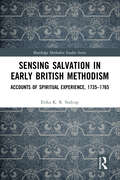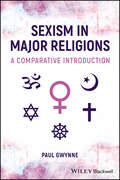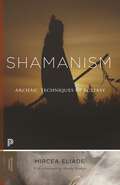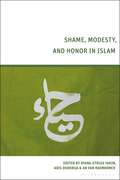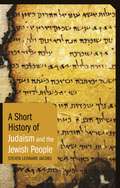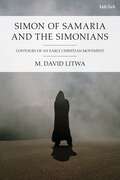- Table View
- List View
The Routledge Handbook of Megachurches (Routledge Handbooks in Religion)
by Afe Adogame Chad M. Bauman Damaris Parsitau Jeaney YipThe Routledge Handbook of Megachurches provides a survey of global megachurch phenomena, with an international slate of authors introducing existing and emerging research on a wide variety of relevant topics.Over the past decade, the field of megachurch studies has matured and become global in its scope and orientation. The Handbook offers 33 chapters by top scholars in the field, focusing in particular on: The location, demographic nature, and transnational connections of megachurches. Megachurch worship, hermeneutics, and theology (in theory and practice). Megachurch institutional dynamics. The various ways that megachurches have both influenced and been influenced by their social contexts in terms of class, age, gender, sexuality, and pop culture. The Handbook's interdisciplinary orientation makes it essential reading for sociologists, political scientists, anthropologists, media specialists, pop culture observers, business strategists, leadership consultants, marketing analysts, scholars of religion, and Christian historians, theologians, and missiologists. Experienced scholars of megachurches will gain valuable insight into aspects of megachurch research beyond their own specializations. Scholars new to the field will find the chapters useful as signposts for where to begin their own academic exploration. Christian pastors and laypeople will learn more about this increasingly prominent and influential form of their faith.
The Routledge Handbook of Megachurches (Routledge Handbooks in Religion)
The Routledge Handbook of Megachurches provides a survey of global megachurch phenomena, with an international slate of authors introducing existing and emerging research on a wide variety of relevant topics.Over the past decade, the field of megachurch studies has matured and become global in its scope and orientation. The Handbook offers 33 chapters by top scholars in the field, focusing in particular on: The location, demographic nature, and transnational connections of megachurches. Megachurch worship, hermeneutics, and theology (in theory and practice). Megachurch institutional dynamics. The various ways that megachurches have both influenced and been influenced by their social contexts in terms of class, age, gender, sexuality, and pop culture. The Handbook's interdisciplinary orientation makes it essential reading for sociologists, political scientists, anthropologists, media specialists, pop culture observers, business strategists, leadership consultants, marketing analysts, scholars of religion, and Christian historians, theologians, and missiologists. Experienced scholars of megachurches will gain valuable insight into aspects of megachurch research beyond their own specializations. Scholars new to the field will find the chapters useful as signposts for where to begin their own academic exploration. Christian pastors and laypeople will learn more about this increasingly prominent and influential form of their faith.
Safety and Security for Churches and Other Places of Worship
by Kevin L. Erskine Joy A. VolpiSafety and Security for Churches and Other Places of Worship is a reference book focused on how to form a first responder team for churches, synagogues, temples, and other places of worship. It will assist team leaders on how to train for both security and medical emergencies, provide training aids and ideas, and how to write SOPs and legal issues. Trending violence directed at soft targets is growing, forcing places of worship to respond with highly trained personnel to quickly intervene. Many medical incidents can have drastically better outcomes if trained medical personnel render immediate medical care. For instance, the use of an AED in conjunction with CPR can drastically improve survival rates from 15% to 85%, versus just CPR alone. Topics covered include: Environmental disasters Acts of violence Active shooter incidents Bomb threats Unruly/disruptive persons Suspect control Sexual abuse Realistic training using fake wounds Tabletop exercises Team building Medical emergencies An equipment chapter helps to determine what equipment is a priority for teams limited by budget. Some equipment can mean the difference between a "friend" being mistaken for an aggressor, resulting in an innocent person being injured or killed. Safety and Security for Churches and Other Places of Worship is a must-have reference for anyone charged with the duty to protect those who attend and work at places of worship.
Safety and Security for Churches and Other Places of Worship
by Kevin L. Erskine Joy A. VolpiSafety and Security for Churches and Other Places of Worship is a reference book focused on how to form a first responder team for churches, synagogues, temples, and other places of worship. It will assist team leaders on how to train for both security and medical emergencies, provide training aids and ideas, and how to write SOPs and legal issues. Trending violence directed at soft targets is growing, forcing places of worship to respond with highly trained personnel to quickly intervene. Many medical incidents can have drastically better outcomes if trained medical personnel render immediate medical care. For instance, the use of an AED in conjunction with CPR can drastically improve survival rates from 15% to 85%, versus just CPR alone. Topics covered include: Environmental disasters Acts of violence Active shooter incidents Bomb threats Unruly/disruptive persons Suspect control Sexual abuse Realistic training using fake wounds Tabletop exercises Team building Medical emergencies An equipment chapter helps to determine what equipment is a priority for teams limited by budget. Some equipment can mean the difference between a "friend" being mistaken for an aggressor, resulting in an innocent person being injured or killed. Safety and Security for Churches and Other Places of Worship is a must-have reference for anyone charged with the duty to protect those who attend and work at places of worship.
Samaritans and Jews in History and Tradition: Changing Perspectives 10 (Copenhagen International Seminar)
by Ingrid HjelmThis volume presents an anthology of 19 seminal studies, some for the first time in English, that explore the history and tradition of the ancient relationship between Samaritans and Jews.The book is arranged into three parts: Methods, Traditions, and History; Samaritan and Jewish Pentateuchs; and Studies in Bible and Tradition, each of which is chronologically ordered. It represents a collection of the author’s previous publications on the relationship between Samaritans and Jews, expanding and supplementing the conclusions of her published books. Recent archaeological developments on Mount Gerizim have demonstrated that our paradigms for writing the ancient histories of the kingdoms and provinces of Samaria and Judah in the Iron II, Persian, and Hellenistic periods must change. These developments also affect how we evaluate and read ancient literary traditions, and several chapters offer challenging new perspectives on well-known themes, narratives, and compositions in this subject area.Samaritans and Jews in History and Tradition: Changing Perspectives 10 will be of interest to students and scholars of biblical studies, theology, comparative religion, the ancient Near East, and in particular, Samaritan and Jewish studies.
Samaritans and Jews in History and Tradition: Changing Perspectives 10 (Copenhagen International Seminar)
by Ingrid HjelmThis volume presents an anthology of 19 seminal studies, some for the first time in English, that explore the history and tradition of the ancient relationship between Samaritans and Jews.The book is arranged into three parts: Methods, Traditions, and History; Samaritan and Jewish Pentateuchs; and Studies in Bible and Tradition, each of which is chronologically ordered. It represents a collection of the author’s previous publications on the relationship between Samaritans and Jews, expanding and supplementing the conclusions of her published books. Recent archaeological developments on Mount Gerizim have demonstrated that our paradigms for writing the ancient histories of the kingdoms and provinces of Samaria and Judah in the Iron II, Persian, and Hellenistic periods must change. These developments also affect how we evaluate and read ancient literary traditions, and several chapters offer challenging new perspectives on well-known themes, narratives, and compositions in this subject area.Samaritans and Jews in History and Tradition: Changing Perspectives 10 will be of interest to students and scholars of biblical studies, theology, comparative religion, the ancient Near East, and in particular, Samaritan and Jewish studies.
Satanism (Elements in New Religious Movements)
by null Joseph P. LaycockWhat is Satanism? The word has functioned as a powerful indictment of one's rivals, an expression of rebellion against authority, and sometimes to describe the deliberate worship of dark, supernatural forces. This Element provides a concise overview of Satanism from its origins in early modern Europe through the present. It covers such topics as legends of the black mass, hell-fire clubs, the Romantic Satanism of Lord Byron and Percy Shelley, and nineteenth-century occultists who expressed reverence for Satan. It describes modern Satanic religions including the Church of Satan, The Temple of Set, The Order of Nine Angles, The Satanic Temple, and others. It also addresses contemporary Satanic Panic from the 1980s through QAnon. This Element should prove useful to anyone seeking to learn more about this complicated and frequently misunderstood tradition.
Savarkar and the Making of Hindutva
by Janaki BakhleA monumental intellectual history of the pivotal figure of Hindu nationalismVinayak Damodar Savarkar (1883–1966) was an intellectual, ideologue, and anticolonial nationalist leader in India&’s struggle for independence from British colonial rule, one whose anti-Muslim writings exploited India&’s tensions in pursuit of Hindu majority rule. Savarkar and the Making of Hindutva is the first comprehensive intellectual history of one of the most contentious political thinkers of the twentieth century.Janaki Bakhle examines the full range of Savarkar&’s voluminous writings in his native language of Marathi, from political and historical works to poetry, essays, and speeches. She reveals the complexities in the various positions he took as a champion of the beleaguered Hindu community, an anticaste progressive, an erudite if polemical historian, a pioneering advocate for women&’s dignity, and a patriotic poet. This critical examination of Savarkar&’s thought shows that Hindutva is as much about the aesthetic experiences that have been attached to the idea of India itself as it is a militant political program that has targeted the Muslim community in pursuit of power in postcolonial India.By bringing to light the many legends surrounding Savarkar, Bakhle shows how this figure from a provincial locality in colonial India rose to world-historical importance. Savarkar and the Making of Hindutva also uncovers the vast hagiographic literature that has kept alive the myth of Savarkar as a uniquely brave, brilliant, and learned revolutionary leader of the Hindu nation.
Savarkar and the Making of Hindutva
by Janaki BakhleA monumental intellectual history of the pivotal figure of Hindu nationalismVinayak Damodar Savarkar (1883–1966) was an intellectual, ideologue, and anticolonial nationalist leader in India&’s struggle for independence from British colonial rule, one whose anti-Muslim writings exploited India&’s tensions in pursuit of Hindu majority rule. Savarkar and the Making of Hindutva is the first comprehensive intellectual history of one of the most contentious political thinkers of the twentieth century.Janaki Bakhle examines the full range of Savarkar&’s voluminous writings in his native language of Marathi, from political and historical works to poetry, essays, and speeches. She reveals the complexities in the various positions he took as a champion of the beleaguered Hindu community, an anticaste progressive, an erudite if polemical historian, a pioneering advocate for women&’s dignity, and a patriotic poet. This critical examination of Savarkar&’s thought shows that Hindutva is as much about the aesthetic experiences that have been attached to the idea of India itself as it is a militant political program that has targeted the Muslim community in pursuit of power in postcolonial India.By bringing to light the many legends surrounding Savarkar, Bakhle shows how this figure from a provincial locality in colonial India rose to world-historical importance. Savarkar and the Making of Hindutva also uncovers the vast hagiographic literature that has kept alive the myth of Savarkar as a uniquely brave, brilliant, and learned revolutionary leader of the Hindu nation.
The Scandal of Pentecost: A Theology of the Public Church
by Professor Wolfgang VondeyThrough a systematic analysis of the conflicts emerging when the public church encounters the public world, The Scandal of Pentecost argues that the public advent of the church stands in continuity with the public scandal of the incarnate and crucified Christ. The book traces the contours of this scandal in the confrontation of the dominant ruling hermeneutic of authority with a Christian hermeneutic of resistance. This highlights the brokenness of the human condition manifested by the church in the drunkenness of the disciples, the speaking in other tongues, the baptism with the Spirit, the empowerment of the flesh, and its public witness to a scandalized world.The effects of the scandal transform both the disciples' individual and communal witness and their public recognition as the church. Through the lens of a symbolic hermeneutic, the public witness of the church at Pentecost reveals a Christian scandal of anthropological proportions: with the outpouring of the Spirit on all flesh the church emerges as the symbol of humanity.
Science, Religion, the Humanities and Hope: Essays in Honour of Willem B. Drees (Issues in Science and Religion: Publications of the European Society for the Study of Science and Theology #8)
by Anne Runehov Michael FullerThis book collects a multidisciplinary range of contributions focusing on the prolific and seminal work of Willem Drees in the fields of philosophy of religion, philosophy of the humanities, and science and theology/religion. Trained in both theoretical physics and theology/philosophy of religion, Drees holds doctoral degrees in both theology and in philosophy and, amongst other distinguished positions, held professorships at the University of Leiden and at the University of Tilburg. Drees was also Editor-in-Chief of Zygon, Journal of Religion & Science, between 2008 and 2018, and served as President of the European Society for the Study of Science and Theology (ESSSAT) between 2002 and 2008. In 2018, he was elected as member of the Royal Holland Society of Sciences and Humanities (KHMW). This contributed volume builds on Drees’ expansive and provocative scholarly contributions, notably around the concept and meaning of naturalism and the humanities to the fields of science and religion, as exemplified by his works Religion, Science and Naturalism (1996) and What Are the Humanities For? (2021). In a time where more and more young people across the globe are entering higher education such cross-disciplinary explorations and (re-)evaluations are vital to the field. Accordingly, by approaching his work from a variety of disciplines this collection illuminates the broad reach of Drees’ work and provides scholars from various fields with many new and rich opportunities avenues for research.
Scripture and Song in Nineteenth-Century Britain
by James Grande and Brian H. MurrayThis volume brings together new approaches to music history to reveal the interdependence of music and religion in nineteenth-century culture. As composers and performers drew inspiration from the Bible and new historical sciences called into question the historicity of Scripture, controversies raged over the performance, publication and censorship of old and new musical forms. From oratorio to opera, from parlour song to pantomime, and from hymn to broadside, nineteenth-century Britons continually encountered elements of the biblical past in song. Both elite and popular music came to play a significant role in the formation, regulation and contestation of religious and cultural identity and were used to address questions of class, nation and race, leading to the beginnings of ethnomusicology. This richly interdisciplinary volume brings together musicologists, historians, literary and art historians and theologians to reveal points of intersection between music, religion and cultural history.
Seductive Spirits: Deliverance, Demons, and Sexual Worldmaking in Ghanaian Pentecostalism (Spiritual Phenomena)
by Nathanael HomewoodPentecostalism, Africa's fastest-growing form of Christianity, has long been preoccupied with the business of banishing demons from human bodies. Among Ghanaian Pentecostals, deliverance is primary among the embodied, experiential gifts—a loud, messy, and noisy experience that ends only when the possessed body falls to the ground silent and docile, the evil spirits rendered powerless in the face of the holy spirit-wielding-prophets. And nowhere is Ghanaian Pentecostal obsession with demons more pronounced than with sexual demons. In this book, Nathanael Homewood examines the frequent and varied experiences of spirit possession and sex with demons that constitute a vital part of Pentecostal deliverance ministries, offering insight into these practices assembled from long-term ethnographic engagement with four churches in Accra, the capital of Ghana. Relying on the uniqueness of the Pentecostal sensorium, this book unravels how spirits and sexuality intimately combine to expand the definition of the body beyond its fleshy boundaries. Demons are a knowledge regime, one that shapes how Pentecostals think about, engage with, and construct the cosmos. Deliverance Pentecostals reiterate and tarry with the demonic, especially sexually, as a realm of invention whereby alternative ways of being, sensing, and having sex are dreamed, practiced, and performed. Ultimately, Homewood argues for a distinction between colonial demonization and decolonial demons, charting another path to understanding being, the body, and sexualities.
Seductive Spirits: Deliverance, Demons, and Sexual Worldmaking in Ghanaian Pentecostalism (Spiritual Phenomena)
by Nathanael HomewoodPentecostalism, Africa's fastest-growing form of Christianity, has long been preoccupied with the business of banishing demons from human bodies. Among Ghanaian Pentecostals, deliverance is primary among the embodied, experiential gifts—a loud, messy, and noisy experience that ends only when the possessed body falls to the ground silent and docile, the evil spirits rendered powerless in the face of the holy spirit-wielding-prophets. And nowhere is Ghanaian Pentecostal obsession with demons more pronounced than with sexual demons. In this book, Nathanael Homewood examines the frequent and varied experiences of spirit possession and sex with demons that constitute a vital part of Pentecostal deliverance ministries, offering insight into these practices assembled from long-term ethnographic engagement with four churches in Accra, the capital of Ghana. Relying on the uniqueness of the Pentecostal sensorium, this book unravels how spirits and sexuality intimately combine to expand the definition of the body beyond its fleshy boundaries. Demons are a knowledge regime, one that shapes how Pentecostals think about, engage with, and construct the cosmos. Deliverance Pentecostals reiterate and tarry with the demonic, especially sexually, as a realm of invention whereby alternative ways of being, sensing, and having sex are dreamed, practiced, and performed. Ultimately, Homewood argues for a distinction between colonial demonization and decolonial demons, charting another path to understanding being, the body, and sexualities.
Selling the Sacred: Religion and Marketing from Crossfit to QAnon
by Mara Einstein Sarah McFarland TaylorThere’s religion in my marketing! There’s marketing in my religion! Selling the Sacred explores the religio-cultural and media implications of a two-sided phenomenon: marketing religion as a product and marketing products as religion. What do various forms of religion/marketing collaboration look like in the twenty-first century, and what does this tell us about American culture and society?Social and technological changes rapidly and continuously reframe religious and marketing landscapes. Crossfit is a “cult.” Televangelists use psychographics and data marketing. QAnon is a religion and big business. These are some of the examples highlighted in this collection, which engages themes related to capitalist narratives, issues related to gender and race, and the intersection of religion, politics, and marketing, among other key issues.The innovative contributors examine the phenomenon of selling the sacred, providing a better understanding of how marketing tactics, married with religious content, influence our thinking and everyday lives. These scholars bring to light how political, economic, and ideological agendas infuse the construction and presentation of the “sacred,” via more traditional religious institutions or consumer-product marketing. By examining religion and marketing broadly, this book offers engaging tools to recognize and unpack what gets sold as “sacred,” what’s at stake, and the consequences.A go-to resource for those working in marketing studies, religious studies, and media studies, Selling the Sacred is also a must-read for religious and marketing professionals.
Selling the Sacred: Religion and Marketing from Crossfit to QAnon
by Mara Einstein Sarah McFarland TaylorThere’s religion in my marketing! There’s marketing in my religion! Selling the Sacred explores the religio-cultural and media implications of a two-sided phenomenon: marketing religion as a product and marketing products as religion. What do various forms of religion/marketing collaboration look like in the twenty-first century, and what does this tell us about American culture and society?Social and technological changes rapidly and continuously reframe religious and marketing landscapes. Crossfit is a “cult.” Televangelists use psychographics and data marketing. QAnon is a religion and big business. These are some of the examples highlighted in this collection, which engages themes related to capitalist narratives, issues related to gender and race, and the intersection of religion, politics, and marketing, among other key issues.The innovative contributors examine the phenomenon of selling the sacred, providing a better understanding of how marketing tactics, married with religious content, influence our thinking and everyday lives. These scholars bring to light how political, economic, and ideological agendas infuse the construction and presentation of the “sacred,” via more traditional religious institutions or consumer-product marketing. By examining religion and marketing broadly, this book offers engaging tools to recognize and unpack what gets sold as “sacred,” what’s at stake, and the consequences.A go-to resource for those working in marketing studies, religious studies, and media studies, Selling the Sacred is also a must-read for religious and marketing professionals.
Sensing Salvation in Early British Methodism: Accounts of Spiritual Experience, 1735-1765 (Routledge Methodist Studies Series)
by Erika K.R. StalcupThis book examines the spiritual experiences of the first British Methodist lay people and the language used to describe those experiences. It reflects on physical manifestations such as shouting, weeping, groaning, visions, and out-of-body experiences and their role in the process of spiritual development. These experiences offer an intimate perspective on the surprisingly holistic origins of the evangelical revival. The study features autobiographical narratives and other first-hand manuscripts in which “ordinary” lay people recount their first impressions of Methodism, their conflicted feelings throughout the conversion process, their approach toward death and dying, and their mixed attitudes toward the task of writing itself. The book will be relevant to scholars of Methodism, evangelicalism and religious history as well as those interested in emotions and religious experience.
Sensing Salvation in Early British Methodism: Accounts of Spiritual Experience, 1735-1765 (Routledge Methodist Studies Series)
by Erika K.R. StalcupThis book examines the spiritual experiences of the first British Methodist lay people and the language used to describe those experiences. It reflects on physical manifestations such as shouting, weeping, groaning, visions, and out-of-body experiences and their role in the process of spiritual development. These experiences offer an intimate perspective on the surprisingly holistic origins of the evangelical revival. The study features autobiographical narratives and other first-hand manuscripts in which “ordinary” lay people recount their first impressions of Methodism, their conflicted feelings throughout the conversion process, their approach toward death and dying, and their mixed attitudes toward the task of writing itself. The book will be relevant to scholars of Methodism, evangelicalism and religious history as well as those interested in emotions and religious experience.
Sexism in Major Religions: A Comparative Introduction
by Paul GwynneA groundbreaking cross-sectional study of the forms and extent of gender inequality in the "Big Five" religions of the world Sexism in Major Religions: A Comparative Introduction provides clear and accessible analyses of the complex forms of androcentrism and patriarchy in five of the world’s major religions—Hinduism, Buddhism, Judaism, Christianity, and Islam. With a unique comparative-thematic methodology, this student-friendly textbook bridges the gap between Religious Studies and courses in Gender and Sexuality Studies, Feminist Studies, Religion and Society, and more. Following a brief introduction to each religious system covered, Sexism in Major Religions defines important terms and concepts in modern religious feminism, including sex and gender, androcentrism and patriarchy, and revolutionary and reform feminisms. Each remaining chapter focuses on one of seven themes representing the main sources and manifestations of religious discrimination against women, such as the gender of the deity, the duties of the mother, and the status of the wife within marriage. Throughout the text, author Paul Gwynne discusses the formal gender-biased teachings and practices, distinctive features, intersecting areas, and core arguments of conservative defenders and feminist critics of each religion. Provides students with deep comparative insight into the similarities and differences between major religions on issues of gender equality Offers a fresh and original approach to exploring the forms of sexism across seven distinct themes Presents a timely and accurate account of the "landscape of sexism" in five of the world's largest religions Includes a dedicated chapter examining the status of intersex and transgender persons in religious systemsDesigned to broaden students' understanding of religions through systematic and impartial discussion, Sexism in Major Religions: A Comparative Introduction is an ideal textbook for undergraduate courses in Religious Studies and Social Sciences programs, as well as an invaluable resource for general readers interested in understanding and reforming sexist features within religious traditions.
Sexism in Major Religions: A Comparative Introduction
by Paul GwynneA groundbreaking cross-sectional study of the forms and extent of gender inequality in the "Big Five" religions of the world Sexism in Major Religions: A Comparative Introduction provides clear and accessible analyses of the complex forms of androcentrism and patriarchy in five of the world’s major religions—Hinduism, Buddhism, Judaism, Christianity, and Islam. With a unique comparative-thematic methodology, this student-friendly textbook bridges the gap between Religious Studies and courses in Gender and Sexuality Studies, Feminist Studies, Religion and Society, and more. Following a brief introduction to each religious system covered, Sexism in Major Religions defines important terms and concepts in modern religious feminism, including sex and gender, androcentrism and patriarchy, and revolutionary and reform feminisms. Each remaining chapter focuses on one of seven themes representing the main sources and manifestations of religious discrimination against women, such as the gender of the deity, the duties of the mother, and the status of the wife within marriage. Throughout the text, author Paul Gwynne discusses the formal gender-biased teachings and practices, distinctive features, intersecting areas, and core arguments of conservative defenders and feminist critics of each religion. Provides students with deep comparative insight into the similarities and differences between major religions on issues of gender equality Offers a fresh and original approach to exploring the forms of sexism across seven distinct themes Presents a timely and accurate account of the "landscape of sexism" in five of the world's largest religions Includes a dedicated chapter examining the status of intersex and transgender persons in religious systemsDesigned to broaden students' understanding of religions through systematic and impartial discussion, Sexism in Major Religions: A Comparative Introduction is an ideal textbook for undergraduate courses in Religious Studies and Social Sciences programs, as well as an invaluable resource for general readers interested in understanding and reforming sexist features within religious traditions.
Shamanism: Archaic Techniques of Ecstasy
by Mircea EliadeThe foundational work on shamanism now available as a Princeton Classics paperbackShamanism is an essential work on the study of this mysterious and fascinating phenomenon. The founder of the modern study of the history of religion, Mircea Eliade surveys the tradition through two and a half millennia of human history, moving from the shamanic traditions of Siberia and Central Asia—where shamanism was first observed—to North and South America, Indonesia, Tibet, China, and beyond. In this authoritative survey, Eliade illuminates the magico-religious life of societies that give primacy of place to the figure of the shaman—at once magician and medicine man, healer and miracle-doer, priest, mystic, and poet. Synthesizing the approaches of psychology, sociology, and ethnology, Shamanism remains the reference book of choice for those interested in this practice.
Shamanism: Archaic Techniques of Ecstasy
by Mircea EliadeThe foundational work on shamanism now available as a Princeton Classics paperbackShamanism is an essential work on the study of this mysterious and fascinating phenomenon. The founder of the modern study of the history of religion, Mircea Eliade surveys the tradition through two and a half millennia of human history, moving from the shamanic traditions of Siberia and Central Asia—where shamanism was first observed—to North and South America, Indonesia, Tibet, China, and beyond. In this authoritative survey, Eliade illuminates the magico-religious life of societies that give primacy of place to the figure of the shaman—at once magician and medicine man, healer and miracle-doer, priest, mystic, and poet. Synthesizing the approaches of psychology, sociology, and ethnology, Shamanism remains the reference book of choice for those interested in this practice.
Shame, Modesty, and Honor in Islam
by Ayang Utriza Yakin, Adis Duderija and An Van RaemdonckWith a particular emphasis on definitions, continuities, and change, this edited volume examines the historical role and function of haya' – or feelings of shame, modesty, and honor – in Islamic theology and law, and explores contemporary Muslims' engagements with the concept. The book explores various conceptions of haya' and the practices associated with the concept in both Muslim majority and minority contexts. The empirically rich contributions reveal how haya' is socially constructed in varying social and cultural environments across the globe. From medieval Islam to the modern day, this book demonstrates the importance of haya' and its temporal and spatial transformations.
A Short History of Judaism and the Jewish People (Short Histories)
by Steven Leonard JacobsIn this exciting addition to Bloomsbury's Short Histories series, Steven Leonard Jacobs critically yet concisely examines the history of Judaism and the Jewish people, drawing from maps, photographs and archives to illuminate the history of one of the world's oldest religions.Beginning by establishing a definition of Judaism, Jacobs explores the historiography of the Jewish people, in addition to the role of memory in charting history. Including a comprehensive breakdown of the history of Judaism, the author splits discussion into defined eras, taking readers from the beginnings of Judaism, to the split between Judah in the South and Israel in the North, the united Monarchy, and the Age of the Prophets. Exploring the social structures and institutions of ancient Israel, Jacobs incorporates key themes such as civic life, economics, and art – before analysing the interactions of Judaism with Romanism and Hellenism. Moving through the Middle Ages and Pre-Modernity, and acknowledging the role of key figures such as Yosef Karo and Moses Mendelssohn, this book brings the narrative up to the present day, and uncovers the foundations of Judaism in modernity.Jacobs' authoritative yet engaging prose shines through each of the thirteen chapters, which seamlessly intertwine to produce a thorough yet concise examination of the history of Judaism and Jewish peoples.
Simon of Samaria and the Simonians: Contours of an Early Christian Movement
by Dr M. David LitwaWho were the Simonians? Beginning in the mid-second century CE, heresiologists depicted them as licentious followers of the first “gnostic,” a supposedly Samarian self-deifier called Simon, who was thought to practice “magic” and became known as the father of all heresies.Litwa examines the Simonians in their own literature and in the literature used to refute and describe them. He begins with Simonian primary sources, namely The Declaration of Great Power (embedded in the anonymous Refutation of All Heresies) and The Concept of Our Great Power (Nag Hammadi codex VI,4). Litwa argues that both are early second-century products of Simonian authors writing in Alexandria or Egypt. Litwa then moves on to examine the heresiological sources related to the Simonians (Justin, the book of Acts, Irenaeus, the author of the Refutation of All Heresies, Pseudo-Tertullian, Epiphanius, and Filaster). He shows how closely connected Justin's report is to the portrait of Simon in Acts, and offers an extensive exegesis and analysis of Simonian theology and practice based on the reports of Irenaeus and the Refutator. Finally, Litwa examines Simonianism in novelistic sources, namely the Acts of Peter and the Pseudo-Clementines. By the time these sources were written, Simon had become the father of all heresies. Accordingly, virtually any heresy could be attributed to Simon. As a result-despite their alluring portraits of Simon-these sources are mostly unusable for the historical study of the Simonian Christian movement. Litwa concludes with a historical profile of the Simonian movement in the second and third centuries.The book features appendices which contain Litwa's own translations of primary Simonian texts.
